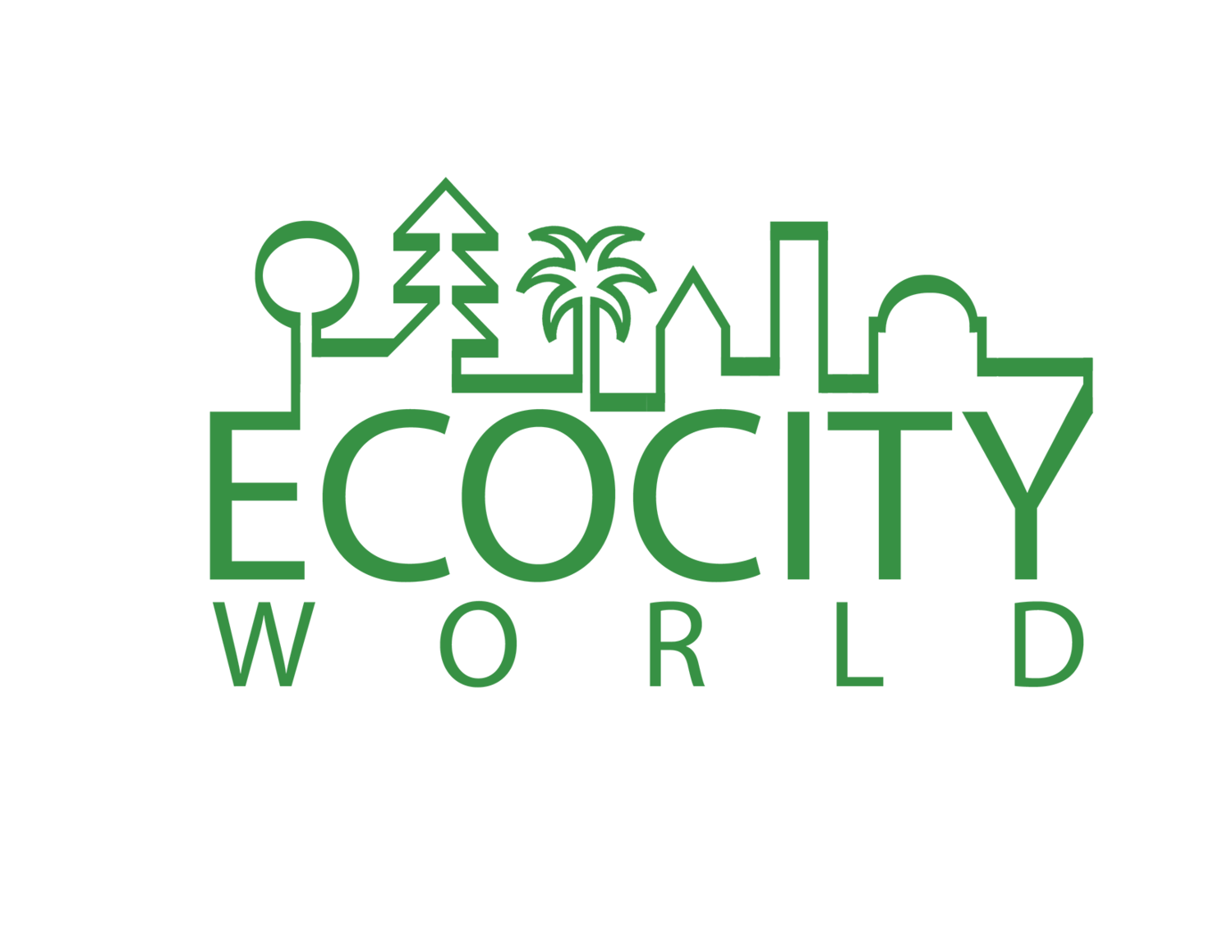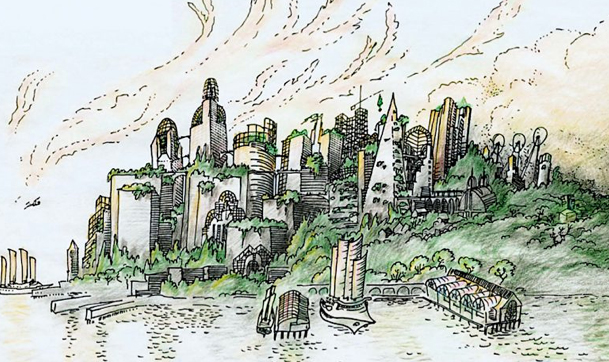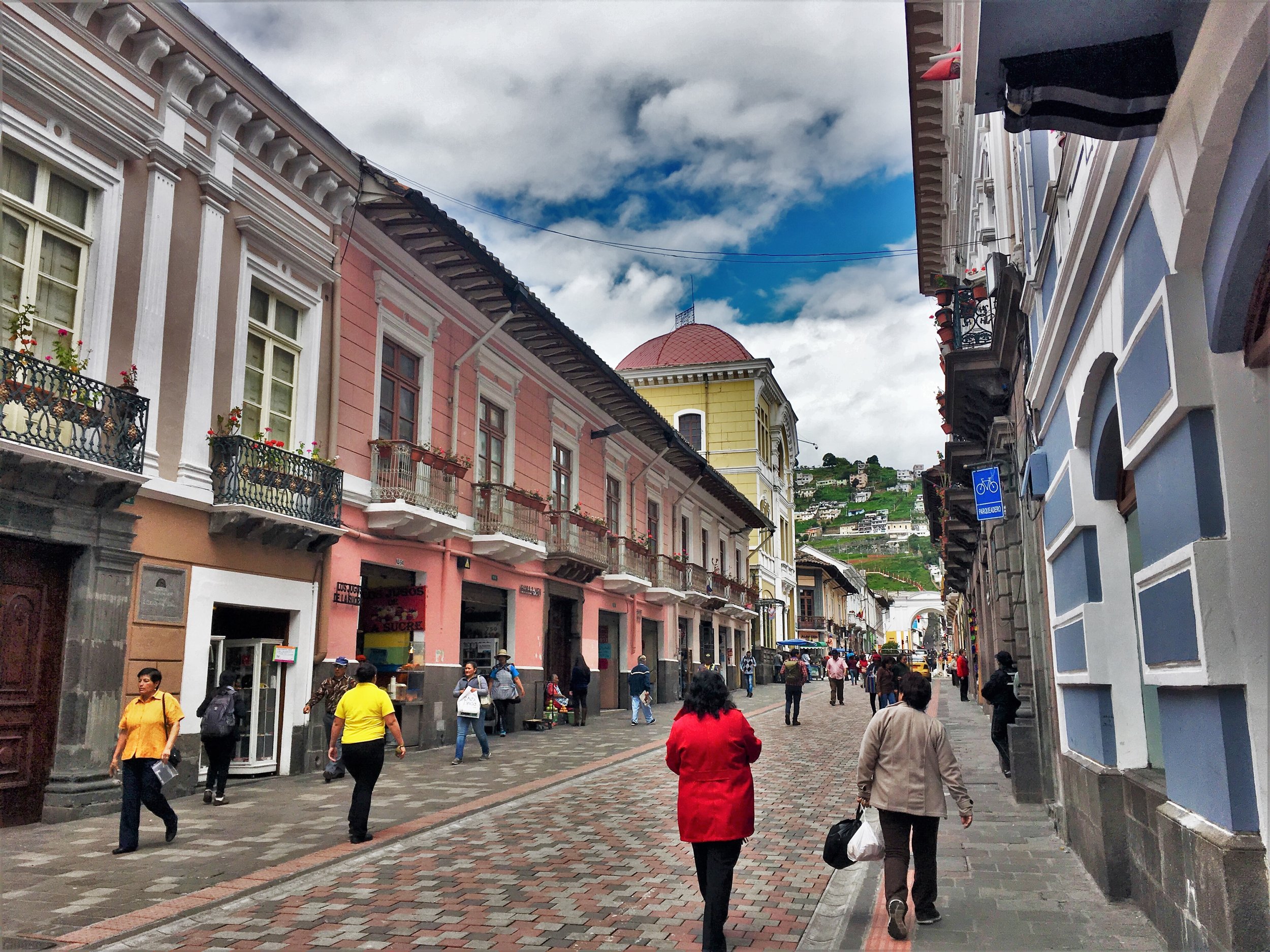An ecocity protects and enhances the collective well-being of life on earth.
Catching the breeze - a hypothetical hot-climate ecocity (all drawings by Richard Register)
An ecocity respects and promotes ecological function and the diversity of non-human life, while at the same time supporting our own physical and emotional health and fostering our highest collective creativity. The ecocity model recognizes and celebrates the reality that humans and non-human nature are inextricably linked, but also that respecting certain boundaries between the two are necessary to maximize the health of both.
Ecocities are most fundamentally defined by highly-organized and deliberate, high-density, pedestrian-focused development, in contrast to the haphazard, undifferentiated, car-driven and car-driving horizontal growth characterizing most of today’s cities. In our increasingly complex and crowded world, ballooning population, production and consumption and their built manifestations have outsized impacts and unintended consequences. But there has also been a corresponding increase in our awareness of these impacts on environment and society, and our understanding of how to predict, measure and prevent them. Clearly, then, we can no longer justify unrestrained, ad-hoc urban development, except to blame it on habit and human nature.
For now, aligning awareness with the right priorities is mostly up to those of us without significant power or resources, but who grasp that the largest creations of our species require nothing short of a remodel.
Principles and Features
Cities are complex living structures, like living organisms. This “anatomy analogy” – that cities should resemble complex living things in their three-dimensionality, compact volumes, efficient use of resources, and responsiveness to local environmental conditions – is the foundation of the ecocity concept and the antithesis of scattered, undifferentiated urban growth.
ECOCITIES ARE BROADLY DEFINED BY:
SMALL FOOTPRINTS IN GEOGRAPHICAL AND ECOLOGICAL TERMS, CONSERVING LAND, ENERGY AND MATERIALS
RESPONSE TO LOCAL CHARACTER AND CONDITIONS, CULTURAL AND NATURAL
“Keyhole" or “view” plaza (drawing by Richard Register)
AND CAN BE BROKEN DOWN INTO THE FOLLOWING FEATURES:
HIGH-DENSITY DEVELOPMENT - COMPLEX & THREE-DIMENSIONAL WITH A NETWORK OF ABOVE-GROUND CONNECTIONS, RATHER THAN SIMPLY COLLECTIONS OF HIGH-RISES
A TRANSPORTATION HIERARCHY, FOCUSED ON PEDESTRIAN-FRIENDLY STREETS & PLAZAS, PRIORITIZING ACCESS & SUPPORT IN THIS ORDER: FOOT : BIKE : RAIL : BUS : CAR-AS-LAST-RESORT
RESTORATION OF WILD & CLOSE-IN AGRICULTURAL LAND THROUGH REVERSAL OF URBAN SPRAWL, PARTICULARLY THROUGH REHABILITATION OF SHORELINES & WATERWAYS
ASSIDUOUS RECYCLING, INCLUDING TREATMENT & REUSE OF ORGANIC WASTE
all things powered by eleCTRICITY, GENERATED FROM RENEWABLE SOURCES, or somatically (by humans)
ENERGY-EFFICIENT STRUCTURES & MASSINGS ATTENTIVE TO LOCAL CLIMATE, INCLUDING GREEN WALLS & ROOFS, SOLAR GREENHOUSES, AND SHADE-CASTING STRUCTURES
“DRAWING NATURE IN” (AS OPPOSED TO “STRETCHING THE CITY OUT”) IN THE FORM OF STREET TREES, GARDENS, GREEN WALLS & ROOFS, WINDOW BOXES, “VIEW PLAZAS,” AND PARKS – FOCUSING ON REGIONALLY NATIVE SPECIES
EMPHASIS ON LOCAL ARCHITECTURAL CHARACTER
Some mix of these elements can be found in most existing cities, but radical improvements to our global urban condition will rely on thoroughly assembling a complete or near-complete suite of ecocity features.
The most radical change, unifying many of these features, is by no means a new idea but cannot be overstated: we need to design cities around the size, speed, and needs, both physical and psychological, of our best selves - not the size, speed and raw demands of machines, especially automobiles. (Yes, the car’s demands have become our own demands too, but only out of compulsion that has evolved into perceived necessity. Cars elevate social status and drive sprawl, which in turn create the “need” for more cars.) Development approaches that accept and even embrace the status quo at the level of overall urban patterns while gradually “greening” structures and infrastructure address some of sprawl’s impacts but not others. Even with the expansion of mass transit, horizontal development ensures that cars remain the dominant mode of transport, encouraging even more sprawl and associated impacts on the natural environment as well as human health and society. And, even electric and automated vehicles will be powered by unsustainable amounts of expensive energy; many technological advances that seem beneficial at face-value are at best short-term solutions that are in fact counter-productive, promoting destructive practices and simply “updating” old problems. (Plus, considerations of status and convenience guarantee that the vast majority of driverless cars will keep their owners and their parking spaces.)
A downtown transformation, before…
…and after (drawings by Richard Register)
Cities have known the automobile for only 1/40 of their existence. Of course we cannot return to the pre-modern world – radically better-designed cities will still require mass transit and a certain number of private vehicles (ideally skewing toward smaller and slower-moving). But neither will drive urban sprawl like today’s massive fleets of automobiles. The need for a human-centered transportation hierarchy - foot : bike : rail : bus : car-as-last-resort - is not news to planners nowadays but it is not yet conventional wisdom and is certainly not common practice. Thus the charge concluding the Fifth International Ecocity Conference, held in Shenzhen in 2002, deserves repeating:









